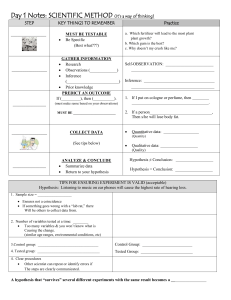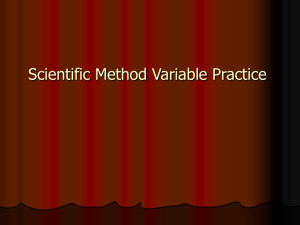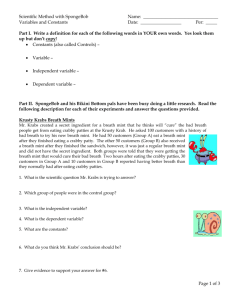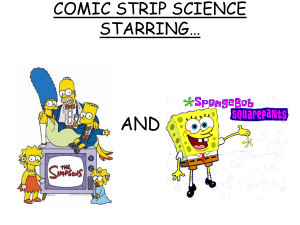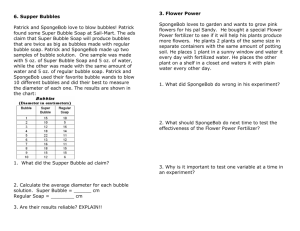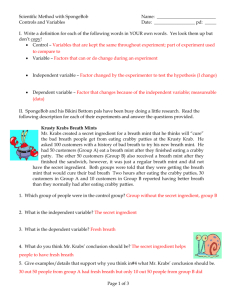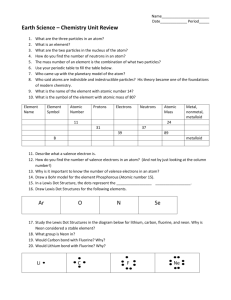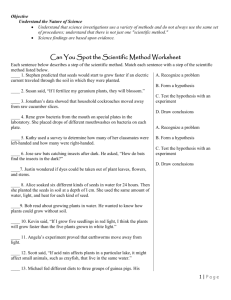Controls & Variables Worksheet: SpongeBob Edition
advertisement
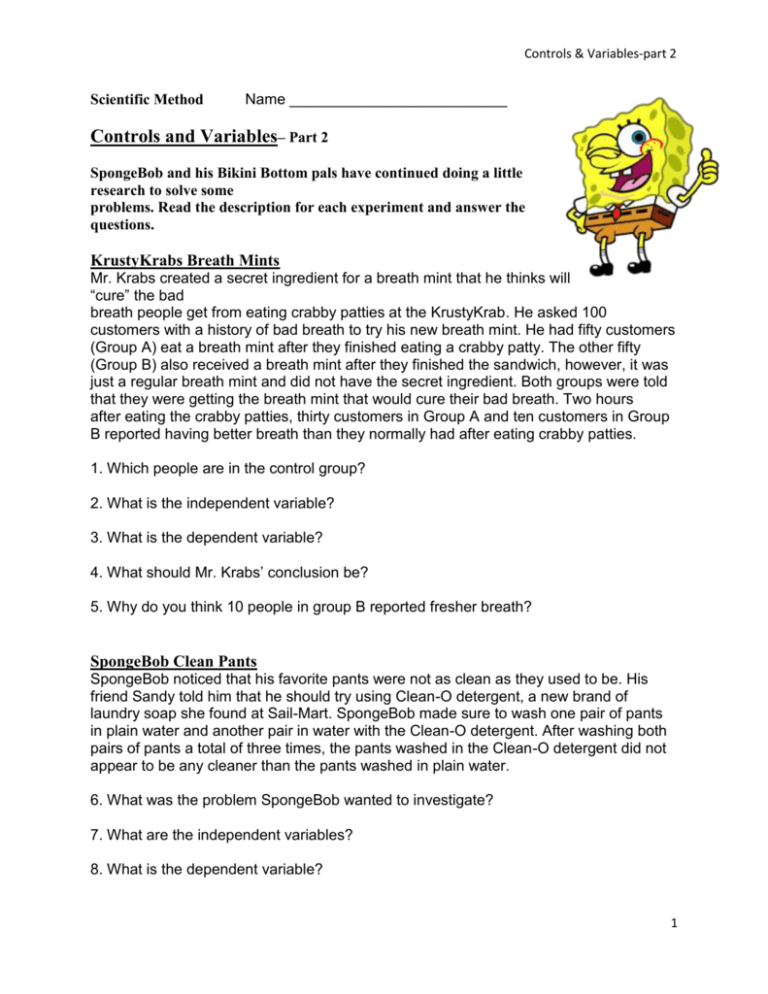
Controls & Variables-part 2 Scientific Method Name __________________________ Controls and Variables– Part 2 SpongeBob and his Bikini Bottom pals have continued doing a little research to solve some problems. Read the description for each experiment and answer the questions. KrustyKrabs Breath Mints Mr. Krabs created a secret ingredient for a breath mint that he thinks will “cure” the bad breath people get from eating crabby patties at the KrustyKrab. He asked 100 customers with a history of bad breath to try his new breath mint. He had fifty customers (Group A) eat a breath mint after they finished eating a crabby patty. The other fifty (Group B) also received a breath mint after they finished the sandwich, however, it was just a regular breath mint and did not have the secret ingredient. Both groups were told that they were getting the breath mint that would cure their bad breath. Two hours after eating the crabby patties, thirty customers in Group A and ten customers in Group B reported having better breath than they normally had after eating crabby patties. 1. Which people are in the control group? 2. What is the independent variable? 3. What is the dependent variable? 4. What should Mr. Krabs’ conclusion be? 5. Why do you think 10 people in group B reported fresher breath? SpongeBob Clean Pants SpongeBob noticed that his favorite pants were not as clean as they used to be. His friend Sandy told him that he should try using Clean-O detergent, a new brand of laundry soap she found at Sail-Mart. SpongeBob made sure to wash one pair of pants in plain water and another pair in water with the Clean-O detergent. After washing both pairs of pants a total of three times, the pants washed in the Clean-O detergent did not appear to be any cleaner than the pants washed in plain water. 6. What was the problem SpongeBob wanted to investigate? 7. What are the independent variables? 8. What is the dependent variable? 1 Controls & Variables-part 2 9. What should Sponge Bob’s conclusion be? Revised by C. Boucvalt from Worksheet created by T. Trimpe 2003 http://sciencespot.net/ Squidward’s Symphony Squidward loves playing his clarinet and believes it attracts more jellyfish than any other instrument he has played. In order to test his hypothesis, Squidward played a song on his clarinet for a total of 5 minutes and counted the number of jellyfish he saw in his front yard. He played the song a total of 3 times on his clarinet and repeated the experiment using a flute and a guitar. He also recorded the number of jellyfish he observed when he was not playing an instrument. The results are shown in the chart. 10. What are the independent variables? 11. What is the dependent variable? 12. What should Squidward’s conclusion be? 13. Are the results reliable? Why or why not? Super Bubbles Patrick and SpongeBob love to blow bubbles! Patrick found some Super Bubble Soap at Sail-Mart. The ads claim that Super Bubble Soap will produce bubbles that are twice as big as bubbles made with regular bubble soap. Patrick and SpongeBob made up two samples of bubble solution. One sample was made with 5 oz. of Super Bubble Soap and 5 oz. of water, while the other was made with the same amount of water and 5 oz. of regular bubble soap. Patrick and SpongeBob used their favorite bubble wands to blow 10 different bubbles and did their best to measure the diameter of each one. The results are shown in the chart. Revised by C. Boucvalt from Worksheet created by T. Trimpe 2003 http://sciencespot.net/ 2 Controls & Variables-part 2 14. What did the Super Bubble ads claim? 15. What are the independent variables? 16. What is the dependent variable? 17. Look at the results in the chart. a. Calculate the average diameter for each bubble solution. Super Bubble = ______ cm Regular Soap = ________ cm b. What should their conclusion be? 18. Are the results reliable? Why or why not? Revised by C. Boucvalt fromWorksheet created by T. Trimpe 2003 http://sciencespot.net/ 3 Controls & Variables-part 2 Answer Key Controls & Variables - Part 2 Revised by C. Boucvalt from Worksheet created by T. Trimpe 2003 http://sciencespot.net/ KrustyKrab Breath Mints 1. Which people are in the control group? The people who received the mint without the secret ingredient; (Group B) would be the control group. 2. What are the independent variables? Secret ingredient in the breath mint and the control group which received the regular/plain mint. 3. What is the dependent variable? Amount of breath odor (or bad breath) which should be given some type of scale; suggestion: qualitative scale of: 1 = bad odor 2 = slight/some odor 3 = no odor 4. What should Mr. Krabs’ conclusion be? The breath mint with the secret ingredient appears to reduce theamount of breath odor more than half the time, but it is not 100% effective. 5. Why do you think 10 people in group B reported fresher breath? This may be due to the placebo effect. Sponge Bob Clean Pants 6. What was the problem? SpongeBob’s pants were not clean. 7. What are the independent variables? Laundry soap and no soap (plain water). Explain to the students that the control would be unstained pants and this will be used to compare the cleaned pants to determine the % of stain removed. 8. What is the dependent variable? Amount of dirt left on the pants (or how clean the pants were). Unless you have a device which can measure the percent/amount of dirt removed, then one person should judge the amount of dirt removed on some type of qualitative scale and compare each to the control which is unstained pants. Suggestion: 1 = no stain removed-0%; 2 = 25% of stain removed; 3 = 50% of stain removed; 4 = 75% of stain removed; and 5 = 100% of stain removed. 9. What should Sponge Bob’s conclusion be? Clean-O laundry soap does not appear to be effective in cleaninghis pants. Squidward’s Symphony 10. What are the independent variables? Instruments: no music (control); clarinet; flute; guitar; 11. What is the dependent variable? Number of jellyfish 12. 12. What should Squidward’s conclusion be? The clarinet did seem to attract a large number of jellyfish, butthe average number for the three trials also matched the average for the guitar. The flute attracted the leastnumber of jellyfish, but the average for this category is still larger than the control. Music seems to attract jellyfish in greater numbers than when no music is played. Squidward’s hypothesis that the clarinet attractslarger numbers of jellyfish than other instruments is not supported by this experiment alone. 13. Are the results reliable? Based on the limited amount of information provided, it is difficult to tell ifSquidward’s results are reliable. The description did not tell how long each break was between trials; if weather conditions were the same; if the same time of day was tested for each group or if heleft enough time for the jellyfish to “clear out” of the area? (NOTE: Accept other potentialflaws thatstudents can support.) 4 Controls & Variables-part 2 Answer Key Controls & Variables - Part 2 continued Revised by C. Boucvalt from Worksheet created by T. Trimpe 2003 http://sciencespot.net/ Super Bubbles 14. What did the Super Bubble ads claim? The ads claimed that the Super Bubble solution would producebubbles that were twice as large as those made with regular bubble soap. 15. What are the independent variables? Type of bubble solution: Regular bubble soap (control)) and Super Bubble soap. 16. What is the dependent variable? Size (diameter in cm) of the bubble 17. a. Calculate the average diameter for each. Super Bubble Average = 15.1 cm. Regular Soap Bubble Average = 11.5 cm b. What should their conclusion be? The Super Bubble solution did not seem to produce bubbles that weretwice as large as those made with the regular soap. Although the average size for the Super Bubblesolution was larger than the average size for the regular soap, it was not “twice as large” as the adsclaimed. In fact, only two of the ten trials had results that would fit the ads claims. 18. Are the results reliable? Why or why not? The description does not say who blew the bubbles for eachsolution. There may be differences in bubble sizes due to the person blowing the bubble rather than the bubblesolution. They might have considered having each person blow 5 bubbles with each solution. Were the temperatures of the room and the bubble solutions the same? (NOTE: Acceptother potential flaws that students can support.) 5
